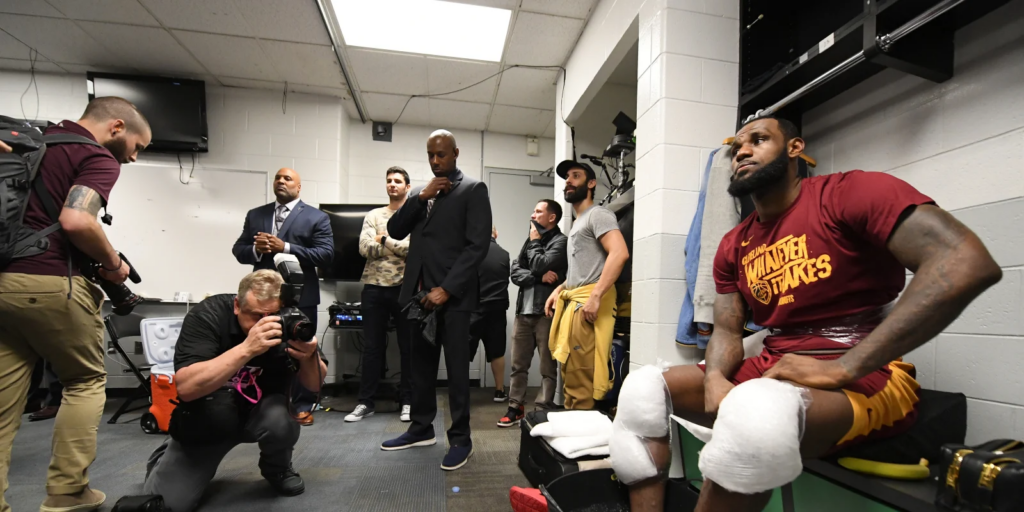NBA players ice their knees to primarily reduce the pain in their knees. The cold from the ice slows down blood flow, which causes there to be less or no inflammation/swelling as well as less soreness. Icing the knees can be done by placing an ice pack on the knees, or as a larger treatment by submerging one’s lower half into an ice bucket/bath; ice packs are more commonly seen on the bench, while ice baths/buckets are more of a locker room treatment.

What causes knee pain and injuries to NBA players?
The knee is the largest joint in the body, responsible for connecting the upper leg and the lower leg as well as bearing the weight of the upper body (in fact, body weight is felt 5x times heavier on the knees). The knee, therefore, is an extremely joint that facilitates movements such as running, jumping, and lateral movements. At the level that the NBA is played at, the knees take on a lot of stress and strong shock impacts, as well as overuse due to high-level games or training occurring multiple days a week.
As such, the knees become highly susceptible to injuries: sprains, straints, tears, fractures, and overall pain. Knee injuries are one of the most common forms of injuries to NBA players, and often result in the most games missed due to time required for recovery, as found in a 2010 study. Jumper’s knee is the most common knee injury that causes pain to the knee cap (patella), that is often a result of a combination of overuse and high shock absorption.
Knee sprains and strains result from damage to the ligaments and tendons, respectively, also from overuse. Anterior cruciate ligament (ACL) tears occur when a player lands incorrectly, stops suddenly, or changes directions quickly; because the ACL connects and stabilizes the different bones in the knee, this injury is often serious. In general, knee injuries can keep you on the bench or in the locker room for a few weeks or it can derail a whole season.
Because of how common knee injuries are, as well as the continued impact on the knees, deteriorating knees impact nearly all players. It can, and has, cut promising careers short before they have even begun, or they can be one of the first signs of a player’s time in the league coming to an end. The fact is, the overuse of the knees starts well before a player’s NBA career, due to extensive training and games starting at young ages.
What are the pros and cons of icing your knees?
Icing your knees after, or even during, a game or practice is an effective way of managing knee pain. Why does it work? By applying an ice pack to the knees, it reduces blood flow to the applied areas, constricting and compressing the blood vessels and muscles in the knee. This slows down the metabolic process, including inflammation; thus, as long as ice is applied, there is reduced inflammation and swelling. The cold also numbs parts of the knee, reducing pain and numbness. It’s a great post-exercise recovery method, but can also be used to manage knee pains in-game, as popularized by Kobe Bryant.
But despite the growing popularity of icing knees, there continues to be less of a clarity as to how effective icing knees are. In theory, icing knees works due to how it manages the blood flow. But scientists are less and less sure about if icing knees are beneficial at all, and are now saying that icing knees has a long-term drawback. By continually icing knees, short-term recovery may be improved, but it may long-term impede the way the body naturally heals. Scientists are calling for a moderation for the use of icing knees, and are promoting a more natural recovery method by implementing load management (coaches or players themselves manage their minutes), performing the right physical therapy and training, and having proper diet, hydration, and sleep.
Do NBA players ice other parts of their body?
Icing the knees is just one part of the overall cold therapy that NBA players, and frankly many other athletes competing at high levels, partake in. Ice buckets or ice baths are quite common as well, as they work similarly to icing the knees. Players submerge their lower body into ice water, or they submerge their whole body below the neck and except the arms and hands into an ice bath for a short period of time (10-15 minutes usually).
But just like icing knees, the benefits of ice baths remain limited and are potentially damaging, according to some scientists. Doctors and scientists have also attributed an interesting factor to the benefits of ice baths: the placebo effect. According to them, by undertaking such a shocking form of therapy, players become convinced that something so painful must work, and they report improvements in recovery and performance, and thus continue to use ice baths extensively.
What other treatments do NBA players undertake for recovery?
Icing your knees right after a game or a practice has been a long-used practice, with many players, coaches, and trainers swearing by it. Newer studies seem to challenge the way that ice is used for recovery, since they tend to find that it negatively impacts long-term healing. That doesn’t mean that ice is out of the picture; it just needs to be used differently. As long as icing remains simple and effective, players will continue to use the method to recover and get back on the court.
